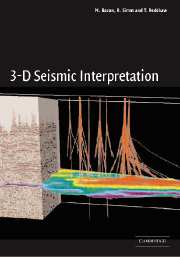Book contents
- Frontmatter
- Contents
- Preface
- 1 Introduction
- 2 3-D seismic data acquisition and processing
- 3 Structural interpretation
- 4 Geological interpretation
- 5 Interpreting seismic amplitudes
- 6 Inversion
- 7 3-D seismic data visualisation
- 8 Time-lapse seismic
- Appendix 1 Workstation issues
- Appendix 2 Glossary
- Appendix 3 Recent developments
- Index
- References
7 - 3-D seismic data visualisation
Published online by Cambridge University Press: 05 March 2013
- Frontmatter
- Contents
- Preface
- 1 Introduction
- 2 3-D seismic data acquisition and processing
- 3 Structural interpretation
- 4 Geological interpretation
- 5 Interpreting seismic amplitudes
- 6 Inversion
- 7 3-D seismic data visualisation
- 8 Time-lapse seismic
- Appendix 1 Workstation issues
- Appendix 2 Glossary
- Appendix 3 Recent developments
- Index
- References
Summary
Recently there has been a change in the way that interpreters view seismic data. The traditional method of working, as explained in chapter 3, has been to make different 2-D sections through the 3-D data volume, as inlines, crosslines, random tracks or time slices. The only way to view more than one section at a time was to open multiple windows and view each one in a separate display. Today, largely thanks to relatively low-cost computer power and memory, it is possible to view entire datasets so that the interpreter can quickly get a feel for the actual 3-D nature of the trap. Indeed, several different data volumes can be viewed simultaneously to interrogate various attribute volumes at the same time (fig. 7.1). This has many applications. As shown in fig. 7.1, reflectivity and coherence volumes can be viewed simultaneously when interpreting a fault; this is a way to combine the lateral continuity information from coherency with the identification of the nature of a feature in the standard reflectivity section. Such technology can also be used to view different AVO volumes in the same display, or to examine reflectivity and acoustic impedance (inversion output) volumes at the same time. Different time-lapse seismic volumes (see chapter 8) can be displayed so that production-related changes can be more easily seen.
Information
- Type
- Chapter
- Information
- 3-D Seismic Interpretation , pp. 172 - 179Publisher: Cambridge University PressPrint publication year: 2003
References
Accessibility standard: Unknown
Why this information is here
This section outlines the accessibility features of this content - including support for screen readers, full keyboard navigation and high-contrast display options. This may not be relevant for you.Accessibility Information
- 1
- Cited by
